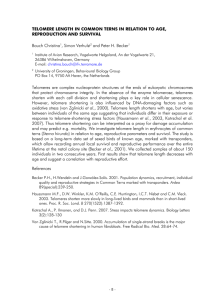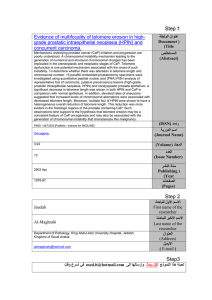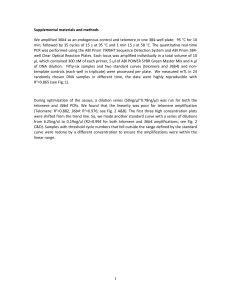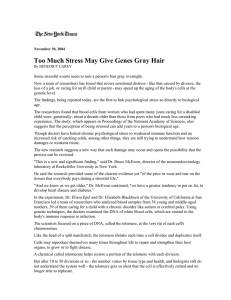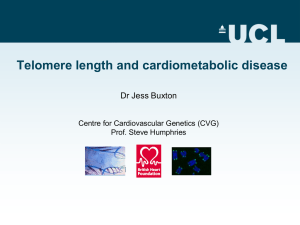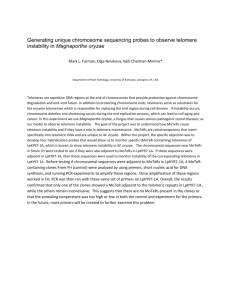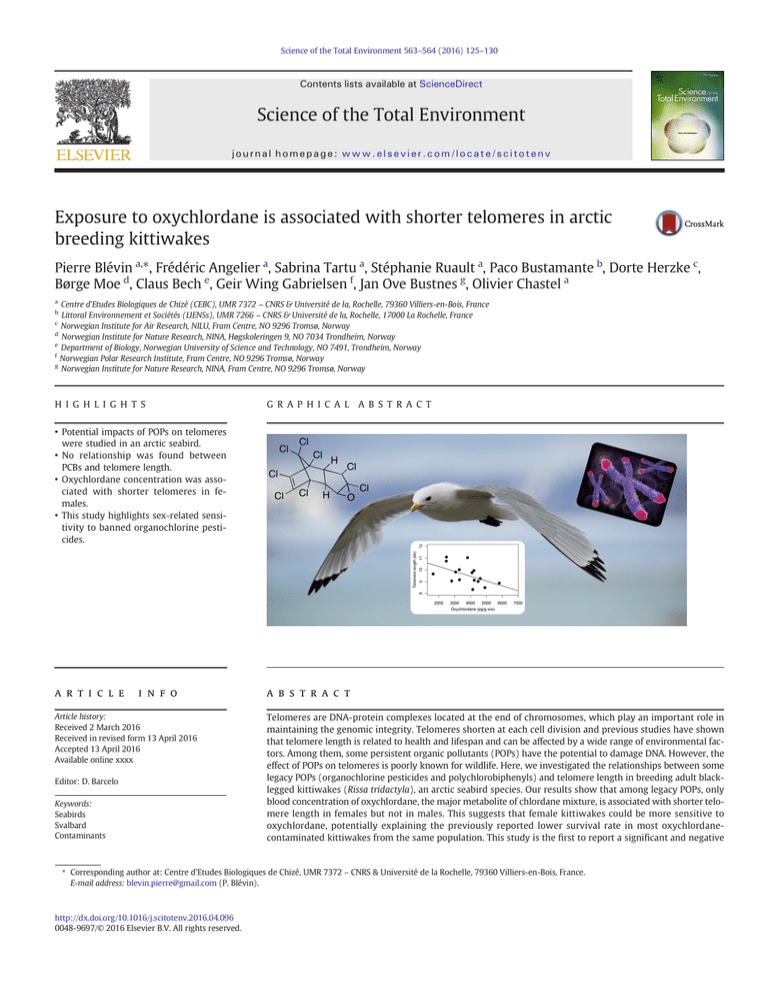
Science of the Total Environment 563–564 (2016) 125–130
Contents lists available at ScienceDirect
Science of the Total Environment
journal homepage: www.elsevier.com/locate/scitotenv
Exposure to oxychlordane is associated with shorter telomeres in arctic
breeding kittiwakes
Pierre Blévin a,⁎, Frédéric Angelier a, Sabrina Tartu a, Stéphanie Ruault a, Paco Bustamante b, Dorte Herzke c,
Børge Moe d, Claus Bech e, Geir Wing Gabrielsen f, Jan Ove Bustnes g, Olivier Chastel a
a
Centre d'Etudes Biologiques de Chizé (CEBC), UMR 7372 – CNRS & Université de la, Rochelle, 79360 Villiers-en-Bois, France
Littoral Environnement et Sociétés (LIENSs), UMR 7266 – CNRS & Université de la, Rochelle, 17000 La Rochelle, France
Norwegian Institute for Air Research, NILU, Fram Centre, NO 9296 Tromsø, Norway
d
Norwegian Institute for Nature Research, NINA, Høgskoleringen 9, NO 7034 Trondheim, Norway
e
Department of Biology, Norwegian University of Science and Technology, NO 7491, Trondheim, Norway
f
Norwegian Polar Research Institute, Fram Centre, NO 9296 Tromsø, Norway
g
Norwegian Institute for Nature Research, NINA, Fram Centre, NO 9296 Tromsø, Norway
b
c
H I G H L I G H T S
G R A P H I C A L
A B S T R A C T
• Potential impacts of POPs on telomeres
were studied in an arctic seabird.
• No relationship was found between
PCBs and telomere length.
• Oxychlordane concentration was associated with shorter telomeres in females.
• This study highlights sex-related sensitivity to banned organochlorine pesticides.
a r t i c l e
i n f o
Article history:
Received 2 March 2016
Received in revised form 13 April 2016
Accepted 13 April 2016
Available online xxxx
Editor: D. Barcelo
Keywords:
Seabirds
Svalbard
Contaminants
a b s t r a c t
Telomeres are DNA-protein complexes located at the end of chromosomes, which play an important role in
maintaining the genomic integrity. Telomeres shorten at each cell division and previous studies have shown
that telomere length is related to health and lifespan and can be affected by a wide range of environmental factors. Among them, some persistent organic pollutants (POPs) have the potential to damage DNA. However, the
effect of POPs on telomeres is poorly known for wildlife. Here, we investigated the relationships between some
legacy POPs (organochlorine pesticides and polychlorobiphenyls) and telomere length in breeding adult blacklegged kittiwakes (Rissa tridactyla), an arctic seabird species. Our results show that among legacy POPs, only
blood concentration of oxychlordane, the major metabolite of chlordane mixture, is associated with shorter telomere length in females but not in males. This suggests that female kittiwakes could be more sensitive to
oxychlordane, potentially explaining the previously reported lower survival rate in most oxychlordanecontaminated kittiwakes from the same population. This study is the first to report a significant and negative
⁎ Corresponding author at: Centre d'Etudes Biologiques de Chizé, UMR 7372 – CNRS & Université de la Rochelle, 79360 Villiers-en-Bois, France.
E-mail address: blevin.pierre@gmail.com (P. Blévin).
http://dx.doi.org/10.1016/j.scitotenv.2016.04.096
0048-9697/© 2016 Elsevier B.V. All rights reserved.
126
Organochlorines
PCBs
DNA
P. Blévin et al. / Science of the Total Environment 563–564 (2016) 125–130
relationship between POPs and telomere length in a free-living bird and highlights sex-related susceptibility to
banned pesticides.
© 2016 Elsevier B.V. All rights reserved.
1. Introduction
Telomeres are DNA-protein complexes located at the end of linear
chromosomes which play a critical role in maintaining the genomic integrity (Blackburn, 1991; Monaghan and Haussmann, 2006). The DNA
polymerase protein complex cannot replicate the very ends of chromosomes during mitosis, and, consequently telomeres shorten at each cell
division (Olovnikov, 1996). When telomeres reach a critical lower
threshold, cell division can damage coding DNA leading to apoptosis
or replicative senescence (Olovnikov, 1996; Campisi et al., 2001). It
was originally thought that telomere loss occurred at a constant rate
in individuals through their life, and telomere length could therefore
act as an internal ‘mitotic clock’ to measure the chronological age of organisms into the wild (Haussmann and Vleck, 2002). However, recent
studies have shown that telomere length predicts survival
(Haussmann et al., 2005; Bize et al., 2009; Salomons et al., 2009;
Heidinger et al., 2012; Angelier et al., 2013; Barrett et al., 2013) and is
related to a wide range of environmental stressors (Mizutani et al.,
2013; Meillère et al., 2015). Consequently, telomere length is considered as more related to biological age than chronological age per se
(Monaghan and Haussmann, 2006; Barrett et al., 2013).
In humans, telomere erosion can be accelerated by different environmental factors such as exposure to pollutants (Zhang et al., 2013).
For instance, it has been reported that outdoor workers exposed to traffic pollution have shorter telomeres than indoor office workers (Hoxha
et al., 2009). Similarly, women telomere length decreases as exposure to
pollution caused by hazardous wastes increases (De Felice et al., 2012).
One underlying mechanism that could potentially explain accelerated
telomere shortening is oxidative stress (Von Zglinicki et al., 2000;
Zhang et al., 2013). This corresponds to the imbalance between the production of reactive oxygen species (ROS) and the antioxidant capacity of
an organism (Finkel and Holbrook, 2000). When metabolic by-products,
such as ROS, are not fully neutralized by anti-oxidant defenses, they
may oxidize cellular macromolecules such as DNA (Houben et al.,
2008). Hence, telomere length may partly reflect oxidative stress history of an individual (Houben et al., 2008). Among contaminants,
some persistent organic pollutants (POPs) have the potential to damage
DNA by triggering oxidative stress and even decrease survival (Fernie
et al., 2005; Isaksson, 2010; Letcher et al., 2010; Erikstad et al., 2013;
Costantini et al., 2014; Sletten et al., 2016). However, the effect of
POPs on telomere length is poorly known for wildlife. To the best of
our knowledge, only one study has addressed this topic in a free-living
animal with low contamination levels but failed to find any significant
relationships (Sletten et al., 2016).
Due to their high volatility and persistence in time, POPs reach remote areas such as the Arctic (Gabrielsen and Henriksen, 2001). Once
deposited in marine ecosystems, living organisms assimilate the POPs
via food intake. The POP concentrations then increase from the marine
environment into the organisms and throughout food webs due to bioaccumulation and biomagnification (Letcher et al., 2010). Seabirds are
top predators; consequently, they are particularly exposed to POPs contamination. They therefore appear as highly relevant biological models
to investigate the influence of POPs on telomere length. A previous
study in a Svalbard population of black-legged kittiwakes Rissa
tridactyla (“kittiwakes” hereafter) has reported high oxidative stress
levels in most POPs contaminated individuals (POPs included
polychlorobiphenyls: PCBs and one organochlorine pesticide: OCP;
Lindsøe, 2012). Additionally, adult survival rate in the same population
of kittiwakes was negatively linked to some OCPs (Goutte et al., 2015).
In this study, we investigated the relationships between some legacy
POPs (OCPs and PCBs) and telomere length in Svalbard kittiwakes. Because telomere length is classically reduced in response to oxidative
stress (Von Zglinicki et al., 2000; Zhang et al., 2013) and often tightly
linked to survival (Haussmann et al., 2005; Bize et al., 2009; Salomons
et al., 2009; Heidinger et al., 2012; Angelier et al., 2013; Barrett et al.,
2013), we predicted that POP levels would be negatively related to telomere length.
2. Materials and methods
2.1. Study area and sampling collection
Fieldwork was carried out in 2012 from July 12th to July 27th in
Krykkjefjellet colony of Kongsfjorden, Svalbard (78°54′N, 12°13′E). A
total of 38 individuals (22 males and 16 females) were caught on their
nest with a noose at the end of a 5 m fishing rod during the chick rearing
period. At capture, a 2 mL blood sample was collected from the alar vein
using a heparinized syringe and a 25G needle to determine legacy POP
levels, telomere length and the sex of individuals. Blood samples were
stored at −20 °C until subsequent analyses. The sex of individuals was
determined from red blood cells by polymerase chain reaction (PCR)
at the Centre d'Etudes Biologiques de Chizé (CEBC) as previously described (Weimerskirch et al., 2005).
2.2. Telomere assay
Telomere length was determined at the CEBC by Southern blot using
the TeloTAGGG Telomere Length Assay (Roche, Mannheim, Germany)
as previously described and with minor modifications (Foote et al.,
2010; Kimura et al., 2010). Telomere length analysis has already been
successfully achieved on the same population of Svalbard kittiwakes
(Schultner et al., 2014a). Briefly, samples were digested with proteinase
K, and DNA was extracted from red blood cells by using the DNeasy
blood and tissue kit (Qiagen). DNA quality was checked by gel electrophoresis and optical density spectrophotometry. Preliminary tests
have been conducted to determine the optimal amount of DNA to be
used and, for each sample, 0.7 μg of DNA was digested with the restriction enzymes HinfI and RsaI for 16 h at 37 °C. Digested DNA samples
were then separated using a pulse-field gel electrophoresis (Bio-Rad)
on a 0.8% agarose gel. All samples were run in four gels. Samples were
randomly assigned to a gel. Internal controls were run on each gel to
measure inter-gel variations. The gels were run at 3.0 V/cm with an initial switch time of 0.5 s to a final switch time of 7 s for 14 h. Following
that step, the gel was depurinated and denaturated in an alkaline solution. The gel was then neutralized and DNA was transferred onto a nitrocellulose membrane by Southern blot (Hybond N+, Amersham Life
Science, Amersham, UK). The membrane was incubated at 120 °C for
20 min in order to fix the DNA. The DNA was then hybridized with a
digoxigenin-labeled probe specific for telomeric sequences and incubated with antidigoxigenin-specific antibody before visualization with
a Chemidoc (Bio Rad). Telomere length was then analyzed using ImageJ
to extract telomere smear densities. Lane-specific background was
subtracted from each density value and telomere length (mean value)
was then calculated using a window of 5–30 kb that includes the
whole smear (Nussey et al., 2014). Inter-gel CV was 1.40%.
2.3. POPs analyses
POPs were analyzed from whole blood at the Norwegian Institute for
Air Research (NILU) in Tromsø, Norway. Only compounds that
P. Blévin et al. / Science of the Total Environment 563–564 (2016) 125–130
potentially affect survival of kittiwakes were considered in this study
(Goutte et al., 2015). Thus, we selected the ∑PCBs (CB-99, -118, -138,
-153, -180, -183 and -187), and the OCPs (HCB, p,p′-DDE, oxychlordane,
trans- and cis-nonachlor). To a blood total sample of 0.5 to 1.5 mL, a
100 μL internal standard solution was added (13C-labeled compounds
from Cambridge Isotope Laboratories: Woburn, MA, USA). The sample
was extracted twice with 6 mL of n-hexane, after denaturation with ethanol and a saturated solution of ammonium sulphate in water. Matrix
removal on florisil columns, separation on an Agilent Technology 7890
GC and detection on an Agilent Technology 5975C MSD were performed
as previously described (Herzke et al., 2009). For validation of the results, blanks (clean and empty glass tubes treated like a sample, 3 in
total) were run for every 10 samples, while standard reference material
(3 in total, 1589a human serum from NIST) was run for every 10 samples. The accuracy of the method was within the 70 and 108% range.
2.4. Statistical analyses
Statistical tests were performed using R 2.13.1 (R Development Core
Team, 2011). We first checked if telomere length and POP levels differed
between sexes using the parametrical test of Welch. The influence of
POPs' contamination on telomere length was investigated with Linear
Models. Thus, ∑POPs, ∑PCBs, HCB, p,p′-DDE, oxychlordane, cis- and
trans-nonachlor were defined as independent variables and telomere
length as the dependent variable. Because blood contaminant concentrations differed between males and females (see Results), including
the factor “sex” and the variable “∑POPs” in the same model could
lead to multicollinearity problems and biased results (Graham, 2003).
Additionally, it is now well established that males and females can
react in different way to environmental stressors such as POPs contamination. Specifically, previous studies conducted on kittiwakes from
Krykkjefjellet colony have reported sex differences regarding body condition, hormones levels, endocrine disruptions, phenology, breeding decision and even survival rate (Goutte et al., 2010, 2015; Schultner et al.,
2014b; Tartu et al., 2013, 2014, 2015a). Therefore, male and female kittiwakes were separated in statistical analyses. Diagnostic plots were
assessed and Shapiro normality tests were performed on residuals to
test whether data sufficiently met the assumption of the linear model.
Multiple testing can potentially lead to misleading results, indicating
statistical significance in situations where there is none. Consequently,
we performed bootstrapping (i.e. resampling method) from the data
sets of significant relationship and then assessed diagnostic plot to corroborate the results (see Supplementary materials; Chernick and
Labudde, 2014). A significance level of α b 0.05 was used for all tests.
127
Table 1
Relationships between whole blood ∑POPs, ∑PCBs, OCPs and telomere length in female
and male chick-rearing black-legged kittiwakes, Rissa tridactyla from Kongsfjorden,
Svalbard.
Dependent variables
Independent variables
df
F
P-value
Females
∑POPs⁎
∑PCBs⁎⁎
1,14
1,14
1,14
1,14
1,14
1,14
1,14
1,20
1.20
1.20
1.20
1.20
1,20
1,20
0.802
0.833
0.534
0.066
5.343
1.246
1.301
0.394
0.114
0.002
1.351
0.025
0.077
0.922
0.386
0.377
0.477
0.801
0.037
0.283
0.273
0.537
0.740
0.967
0.259
0.876
0.785
0.348
Males
Telomere length
Telomere length
HCB
p,p′-DDE
Oxychlordane
cis-Nonachlor
trans-Nonachlor
∑POPs⁎
∑PCBs⁎⁎
HCB
p,p′-DDE
Oxychlordane
cis-Nonachlor
trans-Nonachlor
Significant variables are in bold.
⁎ ∑POPs: CB-99, -118, -138, -153, -180, -183, -187, HCB, p,p′-DDE, oxychlordane, transand cis-nonachlor.
⁎⁎ ∑PCBs: CB-99, -118, -138, -153, -180, -183, -187.
linking oxychlordane exposure and female mortality. Regarding males,
it is thus likely that oxychlordane exposure may lead to a lower survival
rate in another way, independent of telomere attrition. Effects of contaminants on telomere length are still poorly known; most of the studies have focused on humans (Zhang et al., 2013) and to the best of our
knowledge, only one study has investigated the relationships between
POPs and telomere length in wildlife (Sletten et al., 2016).
So far, 11 of the 14 studies investigating the relationship between
telomere length and environmental and occupational chemical exposure in humans, have reported significant negative associations
(Rigolin et al., 2004; Hoxha et al., 2009; Bin et al., 2010; McCracken
et al., 2010; Pavanello et al., 2010; Li et al., 2011; Rollison et al., 2011;
De Felice et al., 2012; Eshkoor et al., 2012; Hou et al., 2012; Wu et al.,
3. Results
Telomere length was not related to sex (t = − 1.438, P-value =
0.160) and ∑POPs tended to be higher in male than in female kittiwakes (t = − 1.976, P-value = 0.056). ∑POPs, ∑PCBs, HCB, p,p′DDE, cis- and trans-nonachlor were not related to telomere length in
male nor in female kittiwakes (All P-values ≥ 0.259; Table 1). In females,
we found a significant and negative association between oxychlordane
and telomere length (Table 1; Fig. 1a). However, we found no relationship between oxychlordane and telomere length in males (Table 1; Fig.
1b).
4. Discussion
Our results on adult kittiwakes showed that among legacy POPs,
only blood concentrations of oxychlordane were negatively associated
with telomere length in females but not in males. Oxychlordane and
chlordane mixture have already been associated with lower survival
in both males and females from the same kittiwake population
(Goutte et al., 2015). Our study reports a negative relationship between
telomere length only in females, thus providing a possible mechanism
Fig. 1. Relationships between telomere length and whole blood oxychlordane
concentrations in female (a) and male (b) chick-rearing black-legged kittiwakes, Rissa
tridactyla from Kongsfjorden, Svalbard.
128
P. Blévin et al. / Science of the Total Environment 563–564 (2016) 125–130
2012). For example, shorter telomeres were associated with pesticide
exposure in patients with myelodysplastic syndrome (Rigolin et al.,
2004; Rollison et al., 2011). Similarly, a study conducted in an apparent
healthy Korean population reported a negative association between
telomere length and exposure to high levels of POPs, including OCPs
(p,p′-DDE, trans-nonachlor and oxychlordane), PCBs and
polybrominated diphenylethers (Shin et al., 2010). The only study investigating relationships between telomere length and contamination
in wildlife has been performed on white-tailed eagle (Haliaeetus
albicilla) chicks in northern Norway (Sletten et al., 2016). In this study,
the authors did not find any relationship between telomere length
and POPs, including OCPs, PCBs and perfluorinated compounds. However, the relatively low levels of contaminants in white-tailed eagle
chicks compared to those measured in adult kittiwakes may explain
the discrepancy in the results. Oxychlordane concentrations in kittiwakes measured in the present study (4019 ± 1315 pg/g ww) were
on average, around 3 times higher than those reported for eagle chicks
(1483 ± 197 pg/g ww). With this exception, our results are thus consistent with previous works and suggest a negative effect of oxychlordane
on telomere length in kittiwakes.
Surprisingly, the relationships between oxychlordane and telomere length were sex dependent and a significant relationship was
found in females, but not in males. How to explain such a difference?
There are some indications that female seabirds may be more sensitive to high levels of OCPs than males. In glaucous gulls (Larus
hyperboreus) and in kittiwakes, OCPs exposure mostly affected survival rate in females (Erikstad et al., 2013; Goutte et al., 2015). Furthermore, in wandering albatrosses (Diomedea exulans), another
long-lived seabird species, the relationships between POP levels
and oxidative stress were dependent of reproductive effort and
breeding females had the highest levels of haptoglobin, a wellknown acute phase protein that indicates an ongoing inflammatory
response which can limit the spread of oxidative damages, compared
to breeding males (Costantini et al., 2014). Thus, the influence of
contaminants on oxidative stress may be exacerbated by reproductive effort. Although kittiwakes are considered to share equally incubation and chick rearing duties (Coulson, 2011), egg production
represents a significant and important cost for females (Monaghan
and Nager, 1997). It is thus possible that the cost of egg production
increases the sensitivity of female kittiwakes to oxychlordane. This
may therefore explain the sex-dependent relationship between telomere length and oxychlordane burden. Furthermore, although
female birds transfer a significant part of their PCBs and DDT burden
to their eggs, oxychlordane on the other hand, seemed to be more selectively retained by the female, at least in female glaucous gulls
(Verboven et al., 2009). In female kittiwakes, it is thus possible that
the energetic cost of clutch production added to the maintenance
of significant oxychlordane levels would exacerbate the toxic effects
of this chlorinated pesticide.
Our study was conducted on breeding adults (i.e. at least 3–4 years
old; Coulson, 2011). However, the birds' age was unknown in our
study, thus a possible confounding factor could be that birds with high
levels of OCPs are the oldest birds with the shortest telomeres. If so,
the negative relationship between oxychlordane and telomere length
would be induced by the age of individuals rather by a direct effect of
oxychlordane on telomere attrition. Although several studies suggested
a negative effect of age on telomere length (Haussmann and Vleck,
2002; Haussmann et al., 2003), other reported that telomere loss mainly
occurs early in life of long-lived seabird (i.e. between chick and adult
stage) rather than during adulthood (Hall et al., 2004; Foote et al.,
2010), as is the case in other vertebrates (Frenck et al., 1998; Rufer
et al., 1998; Zeichner et al., 1999; Friedrich et al., 2001). Additionally,
Haussmann et al. (2003) showed a significant and positive relationship
between telomere length and age in another long-lived seabird species,
the Letch's storm petrel (Oceanodroma leucorhoa). Consequently, effect
of age on telomere length appears to be more complex rather than a
simple negative and constant decrease of telomere length with age. Furthermore, it has been reported that in several seabird species, blood
level of POPs is unrelated to age in adult birds (Bustnes et al., 2003;
Carravieri et al., 2014; Tartu et al., 2015b), and rather reaches a steady
state of equilibrium once adult (Newton et al., 1981; Henriksen, 1995;
Drouillard, 2001; Bustnes et al., 2003). Therefore, it is unlikely that the
negative relationship between oxychlordane and telomere length originates from birds with high levels of oxychlordane being the oldest birds
with the shortest telomeres.
Previous studies have shown decreased antioxidant enzyme activity
in relation to contaminants, such as in herring gulls (Larus argentatus),
where chicks exposed to PCBs combined with dietary restrictions
showed negative relationships between catalase, glutathione peroxidase and contaminant levels (Hegseth et al., 2011). Similarly, significant
negative associations between oxychlordane, p,p′-DDE, PCB-153 and
superoxide dismutase enzyme in white-tailed eagle chicks have been
reported (Sletten et al., 2016). Finally, a significant positive relationship
between oxychlordane, PCBs and oxidative stress was found in a Svalbard population of adult kittiwakes (Lindsøe, 2012). Consequently,
oxychlordane could be possibly involved in the generation of oxidative
stress through an increase of ROS which are known to reduce telomere
length (Von Zglinicki, 2002). As the nucleobase guanine is a major oxidation target for ROS, the (TTAGGG)n repeats, that constitute vertebrate
telomeres, are particularly vulnerable to oxidative attacks (Wang et al.,
2010). In our study, in vivo biomarkers of oxidative stress were not measured. Thus, further studies measuring at the same time POP levels, proxies of oxidative stress and telomere length are thus needed to test if
oxidative stress induced by oxychlordane exposure could be linked to
telomere attrition. Among other potential mechanisms, oxychlordane
could induce a down-regulation of telomerase activity. Indeed, telomere
integrity is largely maintained by a telomerase-based mechanism, in
which the enzyme telomerase plays a key role by adding hexameric
(TTAGGG) repeats to chromosome ends, partially compensating telomere
shortening (Greider and Blackburn, 1989; Xin et al., 2008). However, this
hypothesis seems unlikely since telomerase is generally inactivated in
adult somatic cells of most studied species so far (Monaghan and
Haussmann, 2006; Vleck et al., 2007; but see Hatakeyama et al., 2008).
Consequently, telomerase down-regulation seems to be more a common
feature of large and/or long-lived species (Gomes et al., 2011) rather than
being specifically related to contamination levels.
Extensively used during N 35 years as a pesticide, usage of chlordane,
of which oxychlordane is a major metabolite, tended to decrease in the
80s (U.S. Department of Health and Human Services, 1994). Banned
from use and listed as a legacy POP by the Stockholm convention since
2004, oxychlordane provided a clear diagnostic criterion related to the
lethal poisoning in several bird species (Blus et al., 1983, 1985; Stickel
et al., 1983; Okoniewski and Novesky, 1993; Stansley and Roscoe,
1999; Wiemeyer, 1996). Furthermore, in an experimental study
where female rats were gavage with oxychlordane, high administrated
doses (10 mg·kg−1) revealed acute toxicity, characterized by feed
refusal, rapid weight loss and thymic atrophy. At lower doses
(2.5 mg·kg−1), female rats showed signs of hepatic changes indicative
of microsomal enzyme induction (Bondy et al., 2003). Finally, as previously mentioned, in glaucous gulls and in kittiwakes from Svalbard,
oxychlordane has been associated with lower survival rates, especially
in females (Erikstad et al., 2013; Goutte et al., 2015). In the present
study, among legacy POPs, only oxychlordane was negatively associated
with telomere length in females. Our results are thus consistent with the
idea that oxychlordane is one of the most toxic POPs (Erikstad et al.,
2013). Consequently, female kittiwakes' sensitivity to oxychlordane
could affect telomere length, explaining the previously reported lower
survival rate in highly contaminated female kittiwakes. On the other
side, the lack of relationships between oxychlordane and telomere
length in males suggest that the lowest survival rate of most
oxychlordane contaminated birds is thus probably not mediated by
telomere shortening in male kittiwakes.
P. Blévin et al. / Science of the Total Environment 563–564 (2016) 125–130
This study is the first to report a significant and negative relationship
between POPs and telomere length in wildlife and therefore partly fills
the gap of knowledge about contaminants effect on telomere attrition.
However, the present work has some limitations. First, we did not measure oxidative stress or other potential mechanisms. Thus, further studies measuring at the same time POP levels, proxies of oxidative stress
and telomere length are thus needed to test if oxidative stress induced
by oxychlordane exposure could be linked to telomere attrition. Secondly, among all tested contaminants only blood oxychlordane concentration was negatively associated with telomere length and even
though several studies have reported that oxychlordane is highly toxic
for birds, an experimental approach would enable to confirm the
acute toxicity of this compound on telomere length through oxidative
stress. Finally, our study was conducted on a limited number of individuals and to fully validate our finding, future studies investigating effects
of POPs on telomere length should be conducted on a larger sample size
and other species.
Conflict of interest
The authors declare no competing financial interest.
Acknowledgements
This project was supported by Institut Polaire Français (IPEV project
330 to O.Chastel, no. 2012 R03) and by Agence National de la Recherche
(ANR project PolarTop to O.Chastel, no. ANR 10 CESA 0016) and by the
Research Council of Norway (AVITOX project to J.O. Bustnes, no.
234423). P.Blévin was funded by a PhD grant from University of La
Rochelle. This study was approved by the French and Norwegian Ethic
committees and by the Governor of Svalbard. The authors thank Linda
Hanssen, the staff of the NILU laboratory in Tromsø for their assistance
during the POPs analysis, David Pinaud for statistical advices on bootstrap procedures and multiple testing and the two anonymous referees
for their constructive comments that definitely improved the earlier
version of the manuscript.
Supplementary data to this article can be found online at http://dx.
doi.org/10.1016/j.scitotenv.2016.04.096.
References
Angelier, F., Vleck, C.M., Holberton, R.L., Marra, P.P., 2013. Telomere length, non-breeding
habitat and return rate in male American redstarts. Funct. Ecol. 27, 342–350.
Barrett, E.L.B., Burke, T.A., Hammers, M., Komdeur, J., Richardson, D.S., 2013. Telomere
length and dynamics predict mortality in a wild longitudinal study. Mol. Ecol. 22,
249–259. http://dx.doi.org/10.1111/mec.12110.
Bin, P., Leng, S.G., Cheng, J., Pan, Z.F., Duan, H.W., Dai, Y.F., Li, H.S., Niu, Y., Liu, Q.J., Liu, Q.,
2010. Association between telomere length and occupational polycyclic aromatic hydrocarbons exposure. Zhonghua Yu Fang Yi Xue Za Zhi 44, 535–538.
Bize, P., Criscuolo, F., Metcalfe, N.B., Nasir, L., Monaghan, P., 2009. Telomere dynamics
rather than age predict life expectancy in the wild. Proc. R. Soc. B Biol. Sci. 276,
1679–1683. http://dx.doi.org/10.1098/rspb.2008.1817.
Blackburn, E.H., 1991. Structure and function of telomeres. Nature 350, 569–573.
Blus, L.J., Henny, C.J., Krynitsky, A.J., 1985. Organochlorine-induced mortality and residues
in long-billed curlews from Oregon. Condor 87, 563–565.
Blus, L.J., Pattee, O.H., Henny, C.J., Prouty, R.M., 1983. First records of chlordane-related
mortality in wild birds. J. Wildl. Manag. 47, 196–198.
Bondy, G., Armstrong, C., Coady, L., Doucet, J., Robertson, P., Feeley, M., Barker, M., 2003.
Toxicity of the chlordane metabolite oxychlordane in female rats: clinical and histopathological changes. Food Chem. Toxicol. 41, 291–301.
Bustnes, J.O., Bakken, V., Skaare, J.U., Erikstad, K.E., 2003. Age and accumulation of persistent organochlorines: a study of arctic-breeding glaucous gulls (Larus hyperboreus).
Environ. Toxicol. Chem. 22, 2173–2179.
Campisi, J., Kim, S.H., Lim, C.S., Rubio, M., 2001. Cellular senescence, cancer and aging: the
telomere connection. Exp. Gerontol. 36, 1619–1637.
Carravieri, A., Bustamante, P., Tartu, S., Meillère, A., Labadie, P., Budzinski, H., Peluhet, L.,
Barbraud, C., Weimerskirch, H., Chastel, O., Cherel, Y., 2014. Wandering albatrosses
document latitudinal variations in the transfer of persistent organic pollutants and
mercury to Southern ocean predators. Environ. Sci. Technol. 48, 14746–14755.
http://dx.doi.org/10.1021/es504601m.
Chernick, M.R., LaBudde, R.A., 2014. An Introduction to Bootstrap Methods With Applications to R. John Wiley & Sons.
129
Costantini, D., Meillère, A., Carravieri, A., Lecomte, V., Sorci, G., Faivre, B., Weimerskirch, H.,
Bustamante, P., Labadie, P., Budzinski, H., Chastel, O., 2014. Oxidative stress in relation
to reproduction, contaminants, gender and age in a long-lived seabird. Oecologia 175,
1107–1116. http://dx.doi.org/10.1007/s00442-014-2975-x.
Coulson, J.C., 2011. The Kittiwake. T & AD Poyser.
De Felice, B., Nappi, C., Zizolfi, B., Guida, M., Sardo, A.D.S., Bifulco, G., Guida, M., 2012. Telomere shortening in women resident close to waste landfill sites. Gene 500, 101–106.
http://dx.doi.org/10.1016/j.gene.2012.03.040.
Drouillard, K.G., 2001. Modeling the Toxicokinetics and Biomagnification of
Polychlorinated Biphenyls (PCBs) in Birds. Univ Tromsö, Norway, Thesis.
Erikstad, K.E., Sandvik, H., Reiertsen, T.K., Bustnes, J.O., Strom, H., 2013. Persistent organic
pollution in a high-Arctic top predator: sex-dependent thresholds in adult survival.
Proc. R. Soc. B Biol. Sci. 280, 20131483. http://dx.doi.org/10.1098/rspb.2013.1483.
Eshkoor, S.A., Jahanshiri, F., Ismail, P., Rahman, S.A., Moin, S., Adon, M.Y., 2012. Association
between telomere shortening and ageing during occupational exposure. J. Med.
Biochem. 31, 211–216.
Fernie, K.J., Shutt, J.L., Mayne, G., Hoffman, D., Letcher, R.J., Drouillard, K.G., Ritchie, I.J.,
2005. Exposure to polybrominated diphenyl ethers (PBDEs): changes in thyroid, vitamin A, glutathione homeostasis, and oxidative stress in American kestrels (Falco
sparverius). Toxicol. Sci. 88, 375–383. http://dx.doi.org/10.1093/toxsci/kfi295.
Finkel, T., Holbrook, N.J., 2000. Oxidants, oxidative stress and the biology of ageing. Nature
408, 239–247.
Foote, C.G., Daunt, F., González-Solís, J., Nasir, L., Phillips, R.A., Monaghan, P., 2010. Individual state and survival prospects: age, sex, and telomere length in a long-lived seabird.
Behav. Ecol. 22, 156–161.
Frenck, R.W., Blackburn, E.H., Shannon, K.M., 1998. The rate of telomere sequence loss in
human leukocytes varies with age. Proc. Natl. Acad. Sci. 95, 5607–5610.
Friedrich, U., Schwab, M., Griese, E.U., Fritz, P., Klotz, U., 2001. Telomeres in neonates: new
insights in fetal hematopoiesis. Pediatr. Res. 49, 252–256.
Gabrielsen, G.W., Henriksen, E.O., 2001. Persistent organic pollutants in Arctic animals in
the Barents Sea area and at Svalbard; levels and effects (review). Mem. Natl. Inst.
Polar Res. Spec. Issue 54, 349–364.
Gomes, N., Ryder, O.A., Houck, M.L., Charter, S.J., Walker, W., Forsyth, N.R., Austad, S.N.,
Venditti, C., Pagel, M., Shay, J.W., 2011. Comparative biology of mammalian telomeres: hypotheses on ancestral states and the roles of telomeres in longevity determination. Aging Cell 10, 761–768.
Goutte, A., Angelier, F., Chastel, C.C., Trouvé, C., Moe, B., Bech, C., Gabrielsen, G.W., Chastel,
O., 2010. Stress and the timing of breeding: glucocorticoid-luteinizing hormones relationships in an arctic seabird. Gen. Comp. Endocrinol. 169, 108–116.
Goutte, A., Barbraud, C., Herzke, D., Bustamante, P., Angelier, F., Tartu, S., Clément-Chastel,
C., Moe, B., Bech, C., Gabrielsen, G.W., Bustnes, J.O., Chastel, O., 2015. Survival rate and
breeding outputs in a high Arctic seabird exposed to legacy persistent organic pollutants and mercury. Environ. Pollut. 200, 1–9. http://dx.doi.org/10.1016/j.envpol.2015.
01.033.
Graham, M.H., 2003. Confronting multicollinearity in ecological multiple regression. Ecology 84, 2809–2815.
Greider, C.W., Blackburn, E.H., 1989. A telomeric sequence in the RNA of Tetrahymena telomerase required for telomere repeat synthesis. Nature 337, 331–337.
Hall, M.E., Nasir, L., Daunt, F., Gault, E.A., Croxall, J.P., Wanless, S., Monaghan, P., 2004. Telomere loss in relation to age and early environment in long-lived birds. Proc. R. Soc.
Lond. B Biol. Sci. 271, 1571–1576.
Hatakeyama, H., Nakamura, K.I., Izumiyama-Shimomura, N., Ishii, A., Tsuchida, S., Takubo,
K., Ishikawa, N., 2008. The teleost Oryzias latipes shows telomere shortening with age
despite considerable telomerase activity throughout life. Mech. Ageing Dev. 129,
550–557.
Haussmann, M.F., Winkler, D.W., O'Reilly, K.M., Huntington, C.E., Nisbet, I.C., Vleck, C.M.,
2003. Telomeres shorten more slowly in long-lived birds and mammals than in
short–lived ones. Proc. R. Soc. Lond. B Biol. Sci. 270, 1387–1392.
Haussmann, M.F., Winkler, D.W., Vleck, C.M., 2005. Longer telomeres associated with higher
survival in birds. Biol. Lett. 1, 212–214. http://dx.doi.org/10.1098/rsbl.2005.0301.
Haussmann, M.F., Vleck, C., 2002. Telomere length provides a new technique for aging animals. Oecologia 130, 325–328. http://dx.doi.org/10.1007/s00442-001-0827-y.
Hegseth, M.N., Camus, L., Gorbi, S., Regoli, F., Gabrielsen, G.W., 2011. Effects of exposure to
halogenated organic compounds combined with dietary restrictions on the antioxidant defense system in herring gull chicks. Sci. Total Environ. 409, 2717–2724.
http://dx.doi.org/10.1016/j.scitotenv.2011.04.004.
Heidinger, B.J., Blount, J.D., Boner, W., Griffiths, K., Metcalfe, N.B., Monaghan, P., 2012.
Telomere length in early life predicts lifespan. Proc. Natl. Acad. Sci. 109, 1743–1748.
http://dx.doi.org/10.1073/pnas.1113306109.
Henriksen, E.O., 1995. Levels and Congener Pattern of PCBs in Kittiwake, Rissa tridactyla,
in Relation to Mobilization of Bodylipids Associated with Reproduction Thesis Univ
Tromsö, Norway.
Herzke, D., Nygård, T., Berger, U., Huber, S., Røv, N., 2009. Perfluorinated and other persistent halogenated organic compounds in European shag (Phalacrocorax aristotelis) and
common eider (Somateria mollissima) from Norway: a suburban to remote pollutant
gradient. Sci. Total Environ. 408, 340–348.
Houben, J.M.J., Moonen, H.J.J., van Schooten, F.J., Hageman, G.J., 2008. Telomere length assessment: biomarker of chronic oxidative stress? Free Radic. Biol. Med. 44, 235–246.
http://dx.doi.org/10.1016/j.freeradbiomed.2007.10.001.
Hou, L., Wang, S., Dou, C., Zhang, X., Yu, Y., Zheng, Y., Avula, U., Hoxha, M., Díaz, A.,
McCracken, J., Barretta, F., Marinelli, B., Bertazzi, P.A., Schwartz, J., Baccarelli, A.A.,
2012. Air pollution exposure and telomere length in highly exposed subjects in Beijing, China: a repeated-measure study. Environ. Int. 48, 71–77.
Hoxha, M., Dioni, L., Bonzini, M., Pesatori, A., Fustinoni, S., Cavallo, D., Carugno, M., Albetti,
B., Marinelli, B., Schwartz, J., Bertazzi, P., Baccarelli, A., 2009. Association between leukocyte telomere shortening and exposure to traffic pollution: a cross-sectional study
130
P. Blévin et al. / Science of the Total Environment 563–564 (2016) 125–130
on traffic officers and indoor office workers. Environ. Health 8, 41. http://dx.doi.org/
10.1186/1476-069X-8-41.
Isaksson, C., 2010. Pollution and its impact on wild animals: a meta-analysis on oxidative
stress. EcoHealth 7, 342–350. http://dx.doi.org/10.1007/s10393-010-0345-7.
Kimura, M., Stone, R.C., Hunt, S.C., Skurnick, J., Lu, X., Cao, X., Harley, C.B., Aviv, A., 2010.
Measurement of telomere length by the Southern blot analysis of terminal restriction
fragment lengths. Nat. Protoc. 5, 1596–1607.
Letcher, R.J., Bustnes, J.O., Dietz, R., Jenssen, B.M., Jørgensen, E.H., Sonne, C., Verreault, J.,
Vijayan, M.M., Gabrielsen, G.W., 2010. Exposure and effects assessment of persistent
organohalogen contaminants in arctic wildlife and fish. Sci. Total Environ. 408,
2995–3043. http://dx.doi.org/10.1016/j.scitotenv.2009.10.038.
Li, H., Jönsson, B.A.G., Lindh, C.H., Albin, M., Broberg, K., 2011. N-nitrosamines are associated with shorter telomere length. Scand. J. Work. Environ. Health 316–324.
Lindsøe, L.M., 2012. Humoral Immunity and Oxidative Stress in Black-Legged Kittiwake
(Rissa tridactyla) and Common Eider (Sommateria mollissima) from Svalbard - Related
to Bio Accumulated Organochlorine Contaminants Master thesis Univ Oslo, Norway.
McCracken, J., Baccarelli, A., Hoxha, M., Dioni, L., Melly, S., Coull, B., Suh, E., Vokonas, P.,
Schwartz, J., 2010. Annual ambient black carbon associated with shorter telomeres
in elderly men: veterans affairs normative aging study. Environ. Health Perspect.
118, 1564–1570.
Meillère, A., Brischoux, F., Ribout, C., Angelier, F., 2015. Traffic noise exposure affects telomere length in nestling house sparrows. Biol. Lett. 11, 20150559.
Mizutani, Y., Tomita, N., Niizuma, Y., Yoda, K., 2013. Environmental perturbations influence telomere dynamics in long-lived birds in their natural habitat. Biol. Lett. 9,
20130511.
Monaghan, P., Haussmann, M.F., 2006. Do telomere dynamics link lifestyle and lifespan?
Trends Ecol. Evolution 21, 47–53. http://dx.doi.org/10.1016/j.tree.2005.11.007.
Monaghan, P., Nager, R.G., 1997. Why don't birds lay more eggs? Trends Ecol. Evol. 12,
270–274.
Newton, I., Bogan, J., Marquiss, M., 1981. Organochlorine contamination and age in
sparrowhawks. Environ. Pollut. Ser. Ecol. Biol. 25, 155–160.
Nussey, D.H., Baird, D., Barrett, E., Boner, W., Fairlie, J., Gemmell, N., Hartmann, N., Horn, T.,
Haussmann, M., Olsson, M., Turbill, C., Verhulst, S., Zahn, S., Monaghan, P., 2014. Measuring telomere length and telomere dynamics in evolutionary biology and ecology.
Methods Ecol. Evol. 5, 299–310.
Okoniewski, J.C., Novesky, E., 1993. Bird poisonings with cyclodienes in suburbia: links to
historic use on turf. J. Wildl. Manag. 57, 630–639.
Olovnikov, A.M., 1996. Telomeres, telomerase, and aging: origin of the theory. Exp.
Gerontol. 31, 443–448. http://dx.doi.org/10.1016/0531-5565(96)00005-8.
Pavanello, S., Pesatori, A.C., Dioni, L., Hoxha, M., Bollati, V., Siwinska, E., Mielzyńska, D.,
Bolognesi, C., Bertazzi, P.A., Baccarelli, A., 2010. Shorter telomere length in peripheral
blood lymphocytes of workers exposed to polycyclic aromatic hydrocarbons. Carcinogenesis 31, 216–221.
R Development Core Team, 2011. R: A language and environment for statistical computing., R Foundation for Statistical Computing, Vienna, Austria ISBN 3-900051-07-0
http://www.R-project.org.
Rigolin, G.M., Porta, M.D., Bugli, A.M., Castagnari, B., Mauro, E., Bragotti, L.Z., Ciccone, M.,
Cuneo, A., Castoldi, G., 2004. Flow cytometric detection of accelerated telomere shortening in myelodysplastic syndromes: correlations with aetiological and clinical–
biological findings. Eur. J. Haematol. 73, 351–358.
Rollison, D.E., Epling-Burnette, P.K., Park, J.Y., Lee, J.H., Park, H., Jonathan, K., Cole, A.L.,
Painter, J.S., Guerrier, M., Meléndez-Santiago, J., Fulp, W., Komrokji, R., Lancet, J.,
List, A.F., 2011. Telomere length in myelodysplastic syndromes. Leuk. Lymphoma
52, 1528–1536. http://dx.doi.org/10.3109/10428194.2011.568648.
Rufer, N., Dragowska, W., Thornbury, G., Roosnek, E., Lansdorp, P.M., 1998. Telomere
length dynamics in human lymphocyte subpopulations measured by flow cytometry.
Nat. Biotechnol. 16, 743–747.
Salomons, H.M., Mulder, G.A., van de Zande, L., Haussmann, M.F., Linskens, M.H.K.,
Verhulst, S., 2009. Telomere shortening and survival in free-living corvids. Proc. R.
Soc. B Biol. Sci. 276, 3157–3165. http://dx.doi.org/10.1098/rspb.2009.0517.
Schultner, J., Moe, B., Chastel, O., Bech, C., Kitaysky, A.S., 2014a. Migration and stress during reproduction govern telomere dynamics in a seabird. Biol. Lett. 10, 20130889.
Schultner, J., Moe, B., Chastel, O., Tartu, S., Bech, C., Kitaysky, A.S., 2014b. Corticosterone
mediates carry-over effects between breeding and migration in the kittiwake Rissa
tridactyla. Mar. Ecol. Prog. Ser. 496, 125–133.
U.S. Department of Health and Human Services, 1994. Toxicological profile for chlordane
(update). Agency for Toxic Substances and Disease Registry. TP-93/03.
Shin, J.Y., Choi, Y.Y., Jeon, H.-S., Hwang, J.H., Kim, S.A., Kang, J.H., Chang, Y.S., Jacobs, D.R.,
Park, J.Y., Lee, D.H., 2010. Low-dose persistent organic pollutants increased telomere
length in peripheral leukocytes of healthy Koreans. Mutagenesis 25, 511–516. http://
dx.doi.org/10.1093/mutage/geq035.
Sletten, S., Bourgeon, S., Bårdsen, B.J., Herzke, D., Criscuolo, F., Massemin, S., Zahn, S.,
Johnsen, T.V., Bustnes, J.O., 2016. Organohalogenated contaminants in white-tailed
eagle (Haliaeetus albicilla) nestlings: an assessment of relationships to immunoglobulin levels, telomeres and oxidative stress. Sci. Total Environ. 539, 337–349. http://dx.
doi.org/10.1016/j.scitotenv.2015.08.123.
Stansley, W., Roscoe, D.E., 1999. Chlordane poisoning of birds in New Jersey. USA. Environ.
Toxicol. Chem. 18, 2095–2099.
Stickel, L.F., Stickel, W.H., Dyrland, R.A., Hughes, D.L., 1983. Oxychlordane, HCS-3260, and
nonachlor in birds: lethal residues and loss rates. J. Toxicol. Environ. Health Part Curr.
Issues 12, 611–622.
Tartu, S., Angelier, F., Bustnes, J.O., Moe, B., Hanssen, S.A., Herzke, D., Gabrielsen, G.W.,
Verboven, N., Verreault, J., Labadie, P., 2015a. Polychlorinated biphenyl exposure
and corticosterone levels in seven polar seabird species. Environ. Pollut. 197,
173–180.
Tartu, S., Angelier, F., Wingfield, J.C., Bustamante, P., Labadie, P., Budzinski, H.,
Weimerskirch, H., Bustnes, J.O., Chastel, O., 2015b. Corticosterone, prolactin and egg
neglect behavior in relation to mercury and legacy POPs in a long-lived Antarctic
bird. Sci. Total Environ. 505, 180–188. http://dx.doi.org/10.1016/j.scitotenv.2014.10.
008.
Tartu, S., Gabrielsen, G.W., Blévin, P., Ellis, H., Bustnes, J.O., Herzke, D., Chastel, O., 2014.
Endocrine and fitness correlates of long-chain perfluorinated carboxylates exposure
in Arctic breeding black-legged kittiwakes. Environ. Sci. Technol. 48, 13504–13510.
Tartu, S., Goutte, A., Bustamante, P., Angelier, F., Moe, B., Clément-Chastel, C., Bech, C.,
Gabrielsen, G.W., Bustnes, J.O., Chastel, O., 2013. To breed or not to breed: endocrine
response to mercury contamination by an Arctic seabird. Biol. Lett. 9, 20130317.
Verboven, N., Verreault, J., Letcher, R.J., Gabrielsen, G.W., Evans, N.P., 2009. Differential investment in eggs by Arctic-breeding glaucous gulls (Larus hyperboreus) exposed to
persistent organic pollutants. Auk 126, 123–133. http://dx.doi.org/10.1525/auk.
2009.08039.
Vleck, C.M., Haussmann, M.F., Vleck, D., 2007. Avian senescence: underlying mechanisms.
J. Ornithol. 148, 611–624.
Von Zglinicki, T., 2002. Oxidative stress shortens telomeres. Trends Biochem. Sci. 27,
339–344.
Von Zglinicki, T., Pilger, R., Sitte, N., 2000. Accumulation of single-strand breaks is the
major cause of telomere shortening in human fibroblasts. Free Radic. Biol. Med. 28,
64–74.
Wang, Z., Rhee, D.B., Lu, J., Bohr, C.T., Zhou, F., Vallabhaneni, H., de Souza-Pinto, N.C., Liu,
Y., 2010. Characterization of oxidative guanine damage and repair in mammalian
telomeres. PLoS Genet. 6, e1000951.
Weimerskirch, H., Lallemand, J., Martin, J., 2005. Population sex ratio variation in a monogamous long-lived bird, the wandering albatross. J. Anim. Ecol. 74, 285–291.
Wiemeyer, S.N., 1996. Other organochlorine pesticides in birds. Environ. Contam. Wildl.
Interpret. Tissue Conc. 99–115.
Wu, Y., Liu, Y., Ni, N., Bao, B., Zhang, C., Lu, L., 2012. High lead exposure is associated with
telomere length shortening in Chinese battery manufacturing plant workers. Occup.
Environ. Med. 69, 557–563.
Xin, H., Liu, D., Songyang, Z., 2008. The telosome/shelterin complex and its functions. Genome Biol. 9, 232.
Zeichner, S.L., Palumbo, P., Feng, Y., Xiao, X., Gee, D., Sleasman, J., Goodenow, M., Biggar, R.,
Dimitrov, D., 1999. Rapid telomere shortening in children. Blood 93, 2824–2830.
Zhang, X., Lin, S., Funk, W.E., Hou, L., 2013. Republished: environmental and occupational
exposure to chemicals and telomere length in human studies. Postgrad. Med. J. 89,
722–728.

